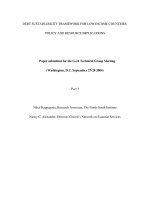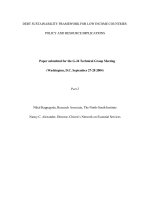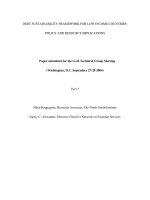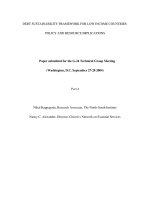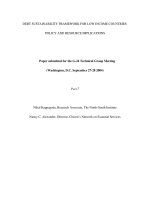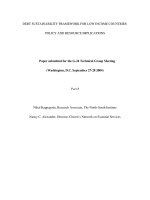DEBT SUSTAINABILITY FRAMEWORK FOR LOW INCOME COUNTRIES : POLICY AND RESOURCE IMPLICATIONS - Part 2
Bạn đang xem bản rút gọn của tài liệu. Xem và tải ngay bản đầy đủ của tài liệu tại đây (40.02 KB, 12 trang )
DEBT SUSTAINABILITY FRAMEWORK FOR LOW INCOME COUNTRIES:
POLICY AND RESOURCE IMPLICATIONS
Paper submitted for the G-24 Technical Group Meeting
(Washington, D.C. September 27-28 2004)
Part 2
Nihal Kappagoda, Research Associate, The North-South Institute
Nancy C. Alexander, Director, Citizen’s Network on Essential Services
introduction
1
1. The Thirteenth Replenishment Agreement of the World Bank’s
International Development Association (IDA), covering the period
2003-5 inclusive, introduced grant financing for the first time in IDA’s
40-year history. The Agreement recognized that unsustainable levels of
debt should be a criterion for eligibility of grants for low-income
borrowers, along with criteria such as the exigencies of natural disasters,
conflict and the HIV/AIDS pandemic. In IDA 13, each borrower was
subject to a cap of grant funding equivalent to 40 percent of its total
IDA allocation. The exact percentage depended on the criteria used to
determine grant eligibility such as unsustainable debt, natural disasters,
etc. There was no distinction drawn among borrowers facing different
degrees of debt-servicing problems. During IDA 13, officials at the
World Bank and International Monetary Fund (IMF) worked on
developing a more systematic basis for differentiating among borrowers
with actual or potential debt servicing problems with a view to
providing higher grant levels to those requiring grants for debt
sustainability.
2. These efforts led to the preparation of a paper entitled “Debt
Sustainability in Low Income Countries: Proposal for an Operational
1
The authors wish to thank Dr Roy Culpeper, President, The North-South Institute, Ottawa for his
assistance.
Framework and Policy Implications”
2
(referred to hereafter as the DSF)
which sets out a proposal for identifying countries in actual or potential
debt distress situations, leading to a formula for determining grant
eligibility within the amounts of resources to be allocated during the
Fourteenth Replenishment of IDA. This paper was discussed by the
Boards of the World Bank and IMF in February and March 2004 and by
the Development Committee in April.
3. Following these discussions and endorsement of the general principles
of the framework, a further paper was prepared by IDA
3
to
operationalize the framework that was proposed in the earlier paper.
The approach adopted in this paper is to determine the level of grants in
the IDA allocation based on the level of debt distress assessed in
relation to the thresholds applicable to the country. These thresholds are
determined by the Country Policy and Institutional Assessments
(CPIAs) done by the World Bank for each borrowing country to judge
its policies and institutional capability, and by the actual or projected
level of the debt indicators that take account of the country’s
vulnerability to exogenous shocks. Consequently the level of grants in
IDA 14 will be an outcome of the framework and not predetermined as
in IDA 13 when a cap of 40 percent was placed for each country.
4. The allocation of IDA funds (grant and or credit) is tied to the
Performance Based Allocation (PBA) system used by IDA which in
2
Debt Sustainability in Low Income Countries: Proposal for an Operational Framework and Policy
Implications by Mark Allen and Gobind Nankani, IMF and IDA, February 3, 2004.
3
Debt Sustainability and Financing Terms in IDA 14, IDA, June 2004.
turn is dependent among other things on the CPIA done for each
borrowing country. The proposed increase in the allocation of grant
funds during IDA 14 has implications for the future funding of IDA, as
future replenishments are dependent on reflows of principal repayments
on credits, unless forgone repayments are offset by a corresponding
increase in the level of replenishment by the donors.
5. The key principle in the framework is to reduce the risk of debt service
problems through grant funding while facilitating access to financing
required by these countries to achieve the objectives of the Millennium
Development Goals (MDGs). Unlike the Highly Indebted Poor
Countries (HIPC) Initiative that was intended to deal with the debt
overhang brought about by past borrowing, the DSF is intended to
reduce the accumulation of future debts to unsustainable levels. This
overarching objective is welcome and would have significant
implications for the volume and type of financial flows to many
developing countries. This paper is intended to assist the countries of
the G24 to better understand the proposed DSF and assess its
implications for the resource requirements of IDA-eligible countries.
6. The next section will discuss the various debt indicators that could be
used to assess debt sustainability. It should be noted that debt
sustainability as a concept began to be used extensively with the HIPC
Initiative of 1996. It is an imprecise concept as evidenced by the need
to use numerous indicators to assess sustainability and monitor them
frequently. The HIPC Initiative itself had to be enhanced three years
after the launch for this reason.
7. This will be followed by a description of the DSF, the PBA system for
IDA allocations (including the CPIA on which it is based) and the grant
component, and the implications for the future financing of IDA. The
concluding section will highlight weaknesses in the proposed
framework, recommend alternative approaches and make suggestions
for further research work by the World Bank and IMF during IDA 14
and after to strengthen its application to individual countries.
Debt Sustainability and Debt Indicators
8. “Debt sustainability” refers to a country’s ability to service its
borrowing, foreign and domestic, public and publicly guaranteed,
private non-guaranteed, including both short- and long-term debt,
without compromising its long-term development goals and objectives.
Countries use various debt indicators and levels to estimate sustainable
levels of borrowing. Sustainability is a dynamic concept that should be
judged using numerous indicators.
